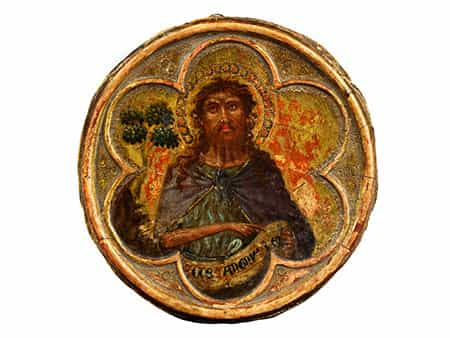Aste Dipinti XVI - XVIII secolo
» rimettere
Il Vostro Art Agent personale

Volete acquistare un oggetto simile?
Volentieri Vi teniamo aggiornati, quando opere simili verranno offerte in una delle nostre prossime aste.
Vi preghiamo di accettare la nostra politica sulla privacy
222
Schule von Siena, letztes Viertel 14. Jahrhundert
JOHANNES DER TÄUFER Tempera auf Holz.
Durchmesser: 9,5 cm.
Prezzo del catalogo € 35.000 - 55.000
Prezzo del catalogo€ 35.000 - 55.000
$ 37,800 - 59,400
£ 31,500 - 49,500
元 273,700 - 430,100
₽ 3,482,150 - 5,471,950
Dieses sehr kleine, qualitativ hochwertige Rundbild war wahrscheinlich Teil eines nicht besonders großen Flügelaltars oder eines mehrtürigen Altardorsals. In einem sechsblättrigen Rahmen sieht man hier als Büste Johannes den Täufer dargestellt. Dieser ist sofort an seinem hageren Gesicht, dem ungepflegten, langen Bart, der Kleidung eines Eremiten und der Papierrolle mit der kanonischen Inschrift „ECCE AGNUS DEI“ zu erkennen, die er in der linken Hand hält, während seine Rechte für den Betrachter darauf zeigt. Bei diesem kostbaren Gemälde erkennt man sofort die Stilmittel der Schule von Siena (letztes Viertel des 14. Jahrhunderts und beginnendes 15. Jahrhundert), zu einer Zeit, als der Einfluss der großen Meister - vor allem von Pietro Lorenzetti (um 1280-1348?) und Ambrogio Lorenzetti (um 1290-um 1348) und Simone Martini (um 1284-1344) - in seiner Maßgeblichkeit zu schwinden begann und so den jungen Malern (genauer der Generation Mitte 14. Jahrhundert und den darauf folgenden Dekaden) die Möglichkeit bot, der Schule von Siena ein neues spätgotisches Gesicht zu verleihen.
Johannes wendet sich hier mit einem intensiven Blick dem Betrachter zu. Seine Gestik ist einfach, aber eindrucksvoll und sehr kommunikativ. Der Bart und das Haar sind detailgetreu dargestellt, die Büste in sich wohlproportioniert. Die solide Raumaufteilung und der überraschende Landschaftshintergrund stellen eine vorsichtige, jedoch sichtbare Annährung an den Naturalismus dar. Aus diesem Grund lässt sich das vorliegende Rundbild (auch wenn hier eine genaue Zuordnung des Künstlers natürlich nicht möglich ist) der Schule von Siena während jener bedeutenden Zeit der Umorientierung gegen Ende des 14. Jahrhunderts zuordnen. Damals waren die wichtigsten Maler Paolo di Giovanni Fei (1345-1411), Andrea di Bartolo (tätig um 1389 - 1428), Martino Di Bartolomeo da Siena/ 1389-1434) und Taddeo di Bartolo (1362-1422). (1032672) (21)
Sienese School, last quarter of the 14th-century
SAINT JOHN THE BAPTIST
Tempera on panel.
Diameter: 9.5 cm.
This very small, premium-quality tondo was probably part of a very large winged altar or a multi-door altar dossal. The bust of Saint John the Baptist is depicted in a six-petalled frame. The saint is immediately recognizable with his haggard face with the unkept, long beard, the hermit's attire and a paper scroll with the canonical inscription "ECCE AGNUS DEI" in his left hand while his right hand is guiding the beholder's gaze by pointing towards it. The stylistic techniques of the Sienese School of the last quarter of the 14th and early 15th century are immediately recognizable in this precious painting. During this period, the influence of the great masters, especially Pietro and Ambrogio Lorenzetti and Simone Martini, was dwindling and thereby gave the younger artists (more specifically the generation of the mid-14th century and the subsequent decades) the opportunity to give the School of Siena a new, Late Gothic face. The solid layout and the surprising landscape background show a careful, yet visible approach towards naturalism. The present tondo can therefore be attributed to the Sienese School during the important period of reorientation towards the end of the 14th century, even if a more exact attribution to a specific artist is not possible. The most important painters of this period were Paolo di Giovanni Fei, Andrea di Bartolo, Martino di Bartolomeo and Taddeo di Bartolo.
This object has been individually compared to the information in the Art Loss Register data bank and is not registered there as stolen or missing.
Il Vostro Art Agent personale
Volete essere informati quando nelle nostre prossime aste un’opera d’arte simile viene offerta? Attivate qui il Vostro Art Agent personale.
Vi preghiamo di accettare la nostra politica sulla privacy
Volete acquistare un oggetto simile?
Il Vostro Art Agent Comprare in Private Sale Date delle aste
I nostri esperti sono felici di assistervi personalmente nella Vostra ricerca di opere d′arte
Volete vendere un'opera simile?
Consegnate ora Vendita privata FAQ
Le vostre consegne sono sempre benvenute. Il nostro team sarà felice di assistervi personalmente in ogni fase trattative. Aspettiamo le vostre chiamate.
Contattate i nostri esperti
further catalogues Mobili & Arredamento | Orologi | Sculture ed Artigianato | Dipinti XVI - XVIII secolo | Tiziano | biblioteca e libros | Vetro, argento, porcellana | Arte russa | Arte asiatica | Dipinti XIX - XX secolo | Arte moderna | Asta di beni di lusso: Borse & valigie | Asta di beni di lusso: Gioielli | Asta di beni di lusso: Orologi da polso | Hampel Living










